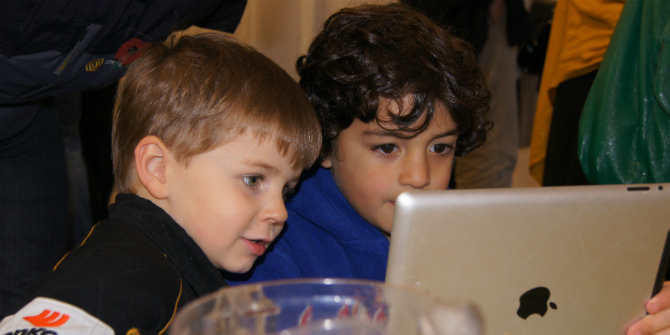
 About one in three internet users today are children. These are the lucky ones: the children whose parents or guardians can afford devices and data that allow them to continue their schooling at a time when COVID-19 has closed schools and turned homes into classrooms. But as many of us know all too well, the pandemic has also interrupted many an education and curtailed many an opportunity. In this post by LSE’s Professor Sonia Livingstone and PhD researcher Anri van der Spuy, we look at why the UN Committee on the Rights of the Child prioritised multistakeholder and multidisciplinary consultation in developing its new General Comment.
About one in three internet users today are children. These are the lucky ones: the children whose parents or guardians can afford devices and data that allow them to continue their schooling at a time when COVID-19 has closed schools and turned homes into classrooms. But as many of us know all too well, the pandemic has also interrupted many an education and curtailed many an opportunity. In this post by LSE’s Professor Sonia Livingstone and PhD researcher Anri van der Spuy, we look at why the UN Committee on the Rights of the Child prioritised multistakeholder and multidisciplinary consultation in developing its new General Comment.
Digital inequality is at least part of the reason why safeguarding children’s digital futures is increasingly important. In a world which is moving online, where everything from dolls to dice are being digitised, children can scarcely afford to lack access and the skills and capacities needed to benefit from the opportunities that technologies may proffer for their futures. At the same time, policymakers need to be prepared to ensure that children can have safe, equitable, diverse, inclusive, and meaningful access to technology-related opportunities, while mitigating the risks that accompany these prospects.
As we previously explained, a significant step was taken in doing so when the UN Committee on the Rights of the Child adopted General Comment 25 on children’s rights in relation to the digital environment. The General Comment is a game changer as it will land on the desk of every government in the world, with invaluable guidance on how to promote and protect children’s rights in increasingly digitised and datafied societies today.
The General Comment is a tool available to treaty bodies like the UN Committee on the Rights of the Child to enable a more thorough understanding of a specific human rights treaty – in this case the UN Convention on the Rights of the Child (UNCRC), which entered into force just over thirty years ago. Then, only about half of a percent of the world’s population were online – meaning that the impact of the internet and other yet-to-emerge technologies were only a blip on the horizon for most. But as digital technologies have become more central to everyday lives, this General Comment provides much-needed context on the impacts of digital environments on children’s rights, no matter where they are, who they are, or whether they even have access to the internet at the moment or not. And perhaps more importantly, UN member states are responsible for upholding the provisions of the UNCRC and must regularly report on how they – and other stakeholders like businesses operating in their jurisdiction – meet such obligations.
This is also why the process that led to the adoption of the General Comment is noteworthy. Digital environments involve policymakers that extend beyond states to include de facto policymakers such as those responsible for laying cables, designing devices, and designing code, programmes, environments and tools. Consequently, the Committee spent years creating and providing opportunities for any and all stakeholders to provide input into how they believed children’s rights should be promoted and protected in digital environments. This represents a critical recognition of the fact that everyone, from governments to educators, to parents and guardians, to the private sector (including the digital giants now playing bigger and bigger roles in children’s lives), civil society organisations, technical community, and more, have a role to play in ensuring children can benefit from the opportunities that digital technologies can – and will, offer.
With the support of the 5Rights Foundation, two rounds of consultation were held to gather these stakeholders’ feedback on what should and should not be in the General Comment (see an example of an in-person expert consultation here). This included consultative discussions at the annual Internet Governance Forum (IGF) and special in-person expert consultations, in addition to opportunities to provide written input. In the first round, 135 submissions were received from NGOs, states, academia, the private sector (though rather few), intergovernmental organisations, and individuals. In the second round, even more submissions were received – including from 28 different states – and each of these was carefully reviewed to strengthen and improve the final output document.
While this multistakeholder consultative approach is quite common in some intergovernmental processes, the Committee went further and also consulted extensively with children in developed and developing contexts alike. More than 700 children and young people between the ages of nine and 22 years old in 26 countries on six continents were consulted on how digital technologies impact their rights, and what action they want to see taken to promote and protect them. In the General Comment, comments from these children are peppered throughout – bringing a refreshing perspective to typically more one-dimensional statements and comments in the UN world.
Many parents and adults worry too much about kids being exposed to technology as they worry for our safety. Well, I don’t disagree with them for that but just want them to at least be informed that children are educated concerning technology in schools and they know how to deal with that
– boy, 15, from Kenya
These consultations were vital to ensuring that the significant proportion of internet users who are children also have a say in the future of how their rights are promoted and protected online. The ways in which the General Comment does so will be examined in future posts, when we will unpack some of the crucial details of this landmark document for the future users of digital technologies (ranging from the need to promote equal and meaningful access to digital technologies, to how we can protect children from the discriminatory potential of technologies like artificial intelligence), along with details of the implementation report, and a children’s version of the GC children’s consultation.
This article represents the views of the authors and not the position of the Media@LSE blog, nor of the London School of Economics and Political Science. To learn more about the LSE Department of Media and Communication’s research, please sign up to our Media@LSE newsletter here.
Featured image: Photo by Annie Spratt on Unsplash





